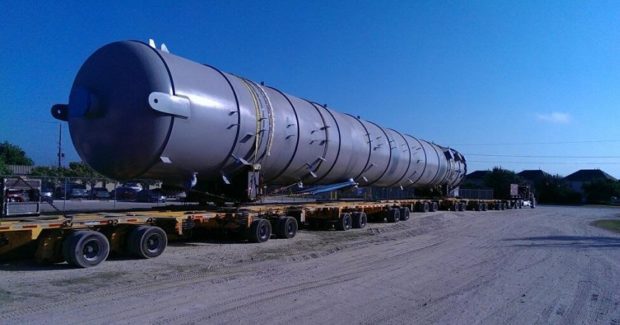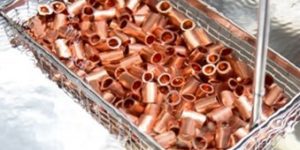Filler Metal Considerations for Pressure Vessels
Filler metal used in welding pressure vessels must provide the appropriate impact toughness to meet strict design temperature requirements. Let’s examine the challenges of finding filler metal combinations, along with obtaining necessary documentation or testing to support welding procedures that can meet the mechanical properties of A516 Gr 70 plate.
Posted: September 3, 2019
For pressure vessel fabrication, ASTM A516 Grade 70 carbon steel plate (A516 Gr 70) has become the predominant material due to its strength and toughness at low service temperatures. It is also popular due to its weldability and the fact that it is commercially readily available. It is commonly produced in thicknesses ranging from 1/4 in to 1-1/2 in. Any thickness above 1-1/2 in requires the material be normalized to ensure its toughness during use. Even though A516 Gr 70 plate is relatively easy to weld, finding filler metal combinations to meet its mechanical properties can prove challenging. Pressure vessels have strict design temperature requirements and the filler metal must be able to provide the appropriate impact toughness at those low temperatures. That is the case even though the operational temperature or the actual temperature encountered in a real-world situation won’t be as extreme. For example, a pressure vessel may have a design temperature as low as -50 deg F, but the pressure vessel won’t actually be subject to that while in service. In essence, having strict design temperature requirement and matching the filler metal to it is a safeguard.
FILLER METAL SELECTION
All filler metals for welding pressure vessels must conform to ASME Boiler and Pressure Vessel Code, Section IX for chemistry. Additionally, welding operators must hold ASME welding certification for the application. When determining the appropriate filler metal combination for welding A516 Gr 70, along with obtaining any necessary documentation or testing to support welding procedures, there are several questions to ask:
- What is the tensile strength and yield strength of the material? A516 Gr 70 plate is available in tensile strengths ranging from 70 ksi to 90 ksi, so the filler metal combinations for root, fill and cap passes must be compatible with its mechanical properties. The minimum yield strength of the A516 Gr 70 plate is 38 ksi.
- What are the Charpy V-notch (CVN) requirements at a particular temperature (Fahrenheit)? CVN values are defined in terms of foot-pounds, which is the energy absorbed during the breaking of a weld specimen when CVN testing occurs. The other factor is the temperature at which the test was conducted. Combined, these two indicate the impact values of the filler metal at a given temperature – or how much force the completed weld can withstand at that temperature before breaking. Typically, A516 Gr 70 plate for pressure vessel fabrication requires a filler metal that provides an average impact toughness of greater than 20 ft-lb at -20 deg F or greater than 20 ft-lbs at -50 deg F. In addition to determining CVN requirements, it’s important to know if there is a minimum CVN requirement. For example, the job may require there is no CVN test less than 15 ft-lb at -50 deg F. Filler metal manufacturers complete CVN tests in lots of five weld test specimens, so in this example, no single test can fall below those minimum values. The average will need to be 20 ft-lb at -20 deg F.
- Will the weld be placed in service in the as-welded condition or stress relieved? Based on the joint design for the pressure vessel application and its intended service conditions, stress relieving may be required after welding. During this process, the pressure vessels are heated in large ovens under a tightly controlled schedule until they reach the required temperature. For A516 Gr 70, that temperate is approximately 1,150 deg F or just below the tempering temperature of the material. The material is typically held at that temperature for one hour per inch of thickness. If the A516 Gr 70 will be stress relieved under these conditions, the chosen filler metal must be formulated for the process and produce welds that are able to withstand the temperature to which they are subjected.
- Is it necessary to qualify procedures based on individual lots of filler metals? Staying on schedule in any industry and for any application is key to meeting deadlines and maintaining good relationships with customers. Running out of filler metal is detrimental to those goals. If companies need to qualify procedures based on individual filler metal lots, it is critical to maintain contact with the filler metal manufacturer regarding lead times. This helps ensure there is enough available inventory for the project.
- Are actual certificates or certificates of conformance needed for the filler metal? In some cases, filler metal manufacturers can provide actual certificates or Certified Material Test Reports (CMTR) that verify lot testing of specific products; however, depending on the product test, there may be an additional cost for these. If companies need these as part of their welding procedures, they should select a filler metal that holds that certificate and meets their CVN requirements or provide lead times to the manufacturer to complete the appropriate testing. These certificates provide the actual mechanical properties of the filler metal for pressure vessel welding. Certificates of Conformance are usually readily available on a filler metal manufacturer’s website. Manufacturers test product for these certificates based on the CVN requirements set forth by the American Welding Society (AWS) for the filler metal classification.
For some filler metals, CVN impact values are tested to temperatures of -40 deg F. Unless listed on the Certificate of Conformance, pressure vessel fabrication requiring CVN impact values at -50 deg F will need additional impact testing to ensure the filler metal can provide that mechanical property. Also, it is important for companies to check that all certificates of conformance provide the necessary information for the application. Details can vary, but include CVN test temperature, diffusible hydrogen levels data and/or mechanical properties after stress relief.
WELDING PROCESSES AND FILLER METAL TYPES
Depending on the design and the mechanical properties required, A516 Gr 70 can be welded with any number of processes and filler metal types. Solid wires, such as AWS ER70S-6, are an option for the root pass, while metal-cored wires and gas-shielded flux-cored wires (FCAW-G) can be used for fill and cap passes. An AWS E70C-6M H4 metal-cored wire is one choice. FCAW-G wires are typically T-12 wires based on ASME Boiler and Pressure Vessel Code, Section IX. AWS E71T-12MJ H4 is one option. Per ASME, these wires are very similar to EXXT-1C and EXXT-1M wires in terms of arc and welding characteristic and deposition rates, but they offer greater impact toughness and lower manganese levels. These features provide a tighter range on tensile strength (70 ksi to 90 ksi for a T-12 wire versus 70 ksi to 95 ksi for a T-1 wire). Submerged arc welding can be used for the fill and cap passes. Appropriate filler metals and fluxes vary depending on the job’s mechanical property needs.
Pressure vessel fabrication is a critical application. Weld failure in these applications could mean catastrophic cost of lives and capital. All facets of the welding process need to be exact to gain the appropriate level of weld quality. Follow the filler metal manufacturer’s recommendations for amperage, voltage and travel speed for the chosen wire diameter.
Derick Railling also co-authored this article. He is a product manager at Hobart Brothers.
















